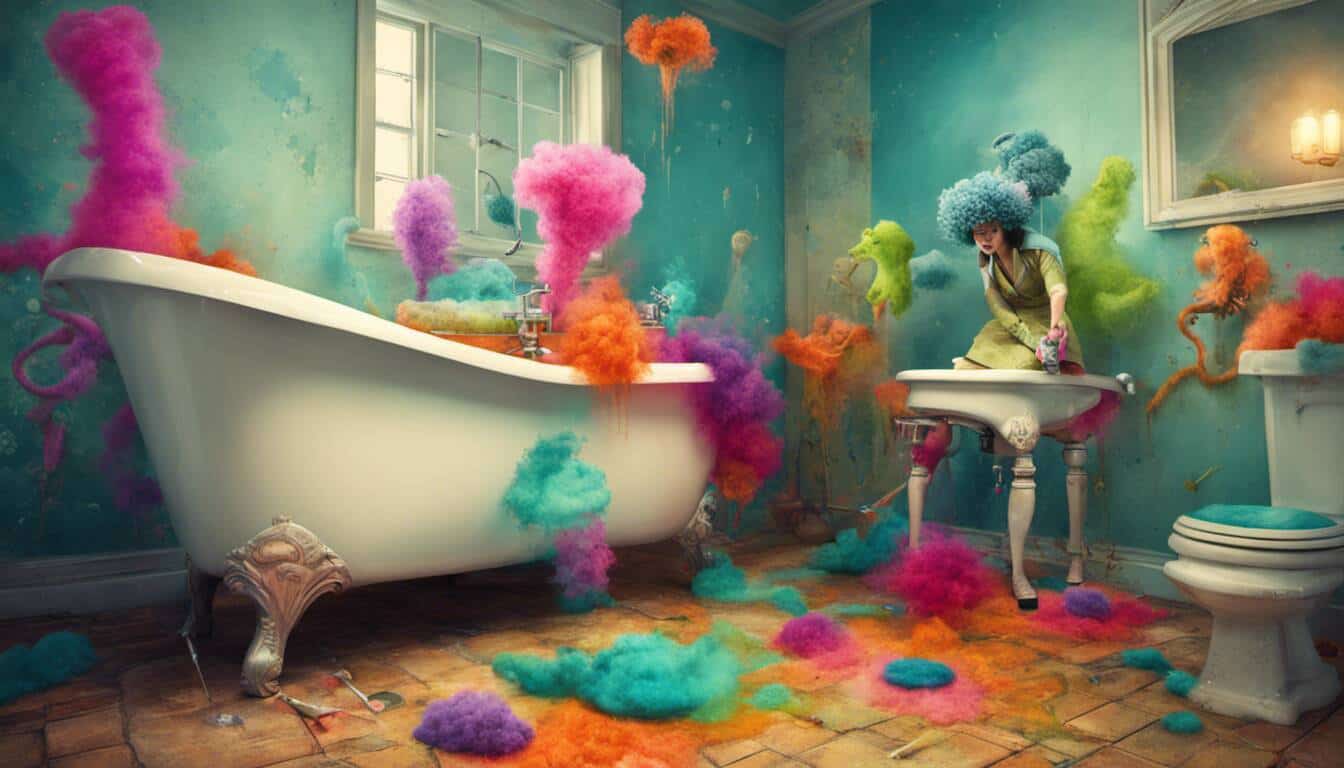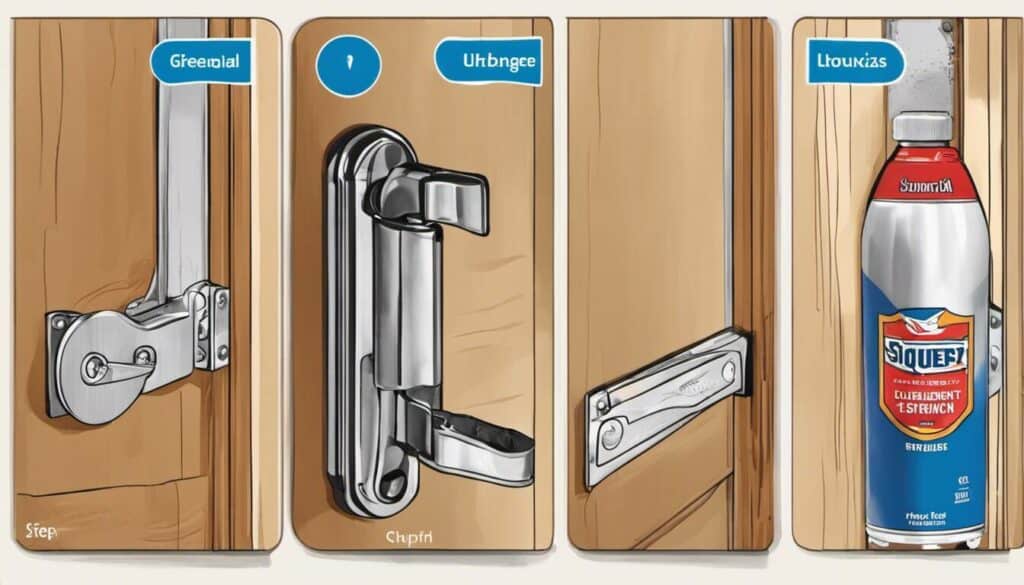In my constant struggle against stubborn bathroom mold, I’ve experienced firsthand the frustration it brings. Bathroom mold doesn’t play fair, sneaking into corners and making its presence known no matter how hard you try removing it. I have tried everything from opening my windows during showers, wiping down my shower walls, to installing an extractor fan. Through trial and error, I have compiled effective strategies to defeat this persistent foe in order to get rid of it once and for all!
To prevent bathroom mold, it is important to keep the bathroom well ventilated. This includes running an exhaust fan during and after showers, leaving the bathroom door open after use, and opening any available windows. Regular cleaning with a mold-specific cleaner can also help prevent the growth of new mold. Additionally, addressing any sources of moisture such as leaks and standing water can reduce the likelihood of mold growth.

“As an analytical microbiologist with specific expertise on indoor molds, I can attest that it’s not enough to just physically remove the visible mold. The root cause, often hidden moisture issues, should be addressed. Remember, uninformed attempts to remove mold may exacerbate the problem. Hence, it’s crucial to seek professional consultation for an effective, safe, and long-lasting solution.”
Dr. Tiberius Balthazar, Analytical Microbiologist
Spotting Bathroom Mold Signs
Bathroom mold can be a sneaky and persistent problem that affects many households. To effectively tackle it, it’s crucial to know how to spot the signs of its presence before it escalates into a bigger issue. Keep an eye out for these telltale signs of bathroom mold:
Imagine stepping into your bathroom after a long day, only to be greeted with an unpleasant musty odor and unusual patchy growths on the walls or ceiling. These are clear indicators that mold has taken hold in this space.
Unusual Patchy Growths and Damp Odour
One common sign of bathroom mold is the appearance of unusual patchy growths on surfaces such as walls, ceilings, or even grout lines between tiles. These patches may vary in color, ranging from black, green, or even pink. The humidity and moisture present in bathrooms create an ideal environment for mold to thrive and multiply.
In addition to visible growths, another notable indicator is a damp odor permeating the air. It often characterizes areas affected by mold infestation. This distinct smell can be quite potent and overpowering, alerting you to the presence of underlying mold issues.
It’s important not to dismiss or ignore these warning signs as they can signify more significant problems lurking beneath the surface. Addressing them promptly will help prevent further damage and potential health risks associated with prolonged exposure to mold.
Now that we have identified some key signs of bathroom mold, let’s explore the various sources of bathroom humidity that contribute to its growth.
- Research from the University of Arizona indicates that up to 22% of showers could have substantial mold growth, with humidity being a significant contributing factor.
- According to the Environmental Protection Agency (EPA), over 60% of US homes have dampness or moisture problems, which are key conditions for the growth and proliferation of mold.
- A study published in Indoor Air Journal in 2022 found that consistent use of bathroom ventilation fans reduced mold occurrence by around 87%.
Sources of Bathroom Humidity
Bathrooms are notorious for being a breeding ground for mold due to the abundance of moisture. Understanding the sources of bathroom humidity is essential in preventing mold growth and ensuring a healthy environment.
One significant factor contributing to bathroom humidity is poor ventilation. Insufficient airflow can trap moisture inside the bathroom, promoting mold growth on various surfaces. Inadequate ventilation can be caused by a lack of exhaust fans or improper usage of existing ones.
Another common source of bathroom humidity is leaky plumbing. Dripping faucets, faulty pipes, or even minor leaks can lead to an increase in moisture levels within the bathroom. Persistent dampness creates an ideal environment for mold to thrive, especially in areas surrounding plumbing fixtures.
Proactively addressing these sources of bathroom humidity is crucial in preventing mold growth and related issues. By implementing suitable strategies and making necessary repairs, you can maintain a dry and mold-free environment.
Poor Ventilation and Leaky Plumbing
Inadequate ventilation plays a significant role in the buildup of moisture in bathrooms, making it one of the primary causes of mold growth. When hot showers or baths are taken without proper ventilation, the steam generated saturates the air with water vapor. Without an efficient ventilation system, this moist air remains trapped inside the bathroom, increasing the chances of mold development.
Similarly, leaky plumbing contributes significantly to elevated humidity levels in bathrooms. Even small leaks from faucets, pipes, or toilet connections continuously release moisture into the surrounding area. Over time, this persistent moisture allows mold spores to take root on walls, floors, or even cabinetry.
Addressing poor ventilation can involve adding or improving exhaust fans that effectively remove excess humidity from the bathroom. Additionally, using dehumidifiers or opening windows during showers can help promote better airflow and prevent condensation, which are key factors in mold prevention.
To tackle leaky plumbing issues effectively, it’s important to identify and repair any leaks promptly. Regularly inspecting plumbing fixtures, checking for signs of moisture or water damage, and addressing any issues immediately can help prevent mold growth due to leaks.
Imagine you’ve noticed water stains on your bathroom ceiling, splotches that weren’t there before. It’s likely a sign of a hidden plumbing leak. By taking swift action to identify and fix the source of the leak, you can prevent further damage and halt the progression of mold growth.
Whether it’s improving ventilation or fixing plumbing leaks, being proactive in tackling these sources of bathroom humidity is vital in the fight against mold. Remember, prevention is key, as it saves you from costly repairs and ensures a healthier living space.
Mold Damage Repair and Cleanup
When dealing with bathroom mold, it’s essential to address the damage caused by its growth. The extent of the damage will vary depending on factors such as the type of mold, the duration of growth, and the materials affected. To ensure effective mold damage repair and cleanup, it’s crucial to follow these steps.
Firstly, assess the extent of the damage. Is it localized or spread throughout the bathroom? This will determine whether you can handle the cleanup yourself or if professional assistance is necessary.
In cases where the mold growth is minimal and limited to small areas, you may be able to tackle the cleanup independently. Ensure that you take appropriate precautions such as wearing protective gear like gloves, goggles, and a face mask to avoid exposure to mold spores.
Next, remove any affected materials such as wallpaper, drywall, or tiles that cannot be salvaged. Dispose of them properly in sealed bags to prevent further contamination.
Once all affected materials are removed, thoroughly clean and disinfect the area using commercial mold cleaners or natural alternatives like vinegar or hydrogen peroxide solutions. Scrub all surfaces, including walls, ceilings, and fixtures.
Now that we understand the basic steps for mold damage repair and cleanup let’s explore safe decontamination techniques to ensure thorough removal of mold and prevent future infestation.
Safe Decontamination Techniques
Proper decontamination is crucial when dealing with bathroom mold to prevent its recurrence. Here are some safe decontamination techniques you can employ to effectively eliminate mold:
- Ventilation: Ensure proper ventilation in your bathroom by opening windows or using exhaust fans during and after showering. Adequate airflow helps reduce moisture levels which inhibit mold growth.
- Drying surfaces: After showering or cleaning your bathroom, make sure to dry surfaces thoroughly. Wipe down damp areas with towels or squeegees to discourage mold from establishing a foothold.
For example, if you notice condensation on bathroom walls or window sills, wipe them dry promptly to prevent water from lingering and creating a conducive environment for mold growth.
- Sealing grout: Properly seal the grout in your bathroom tiles to prevent moisture infiltration. This helps reduce the chances of mold growth between tiles and ensures easier cleanup if any mold does occur.
- Regular cleaning: Keep your bathroom clean and free from potential mold sources by regularly cleaning surfaces, fixtures, and fittings. Use appropriate cleaners and disinfectants that are effective against mold.
By employing these safe decontamination techniques, you can minimize the risk of mold recurring in your bathroom and maintain a healthy environment.
Preventing Future Mold Infestation
Preventing future mold infestation in your bathroom requires a proactive approach to minimize moisture and promote proper ventilation. One of the first steps you can take is to maintain good airflow by keeping the bathroom door open during and after a shower. This allows moist air to circulate and helps prevent trapped humidity that can lead to mold growth.
In addition to keeping the door open, consider utilizing an exhaust fan or installing a humidity bathroom switch to control humidity levels effectively. The exhaust fan helps pull out moist air, reducing condensation on surfaces and preventing excess moisture from lingering in the bathroom.
Imagine this scenario: You’ve just finished taking a long, hot shower, and you can feel the warm steam enveloping the room. Without any proper ventilation, that steam can quickly turn into excess moisture that lingers on your bathroom walls and ceilings, creating an ideal environment for mold growth. By running an exhaust fan or installing a humidity bathroom switch, you can efficiently remove the excess moisture and reduce the chances of mold developing.
Another vital aspect of mold prevention is addressing any sources of water leaks or drips promptly. Check for any leaks from water supply lines or drain pipes under your sink and fix them immediately. Additionally, be vigilant about condensation issues around toilets. Faulty toilet seals or condensation buildup can provide suitable conditions for mold growth. Ensuring proper ventilation through bathroom fans and addressing any condensation problems will help prevent mold from taking hold.
Aside from these practical measures, it’s essential to maintain cleanliness in your bathroom. Regularly cleaning your bathroom surfaces, including walls, ceilings, tiles, and shower surrounds with a specialized mold cleaner or vinegar solution, can inhibit the growth of mold spores. Avoid using regular soap as it won’t effectively eliminate mold spores or prevent their regrowth.
Think of preventing future mold infestation as maintaining a clean kitchen counter. Just as you wipe down the counter regularly to prevent bacteria growth, regularly cleaning your bathroom surfaces helps inhibit mold growth and maintain a healthy environment.
Lastly, keeping an eye on any signs of moisture accumulation or mold growth is crucial. Regularly inspect your bathroom for any signs of water stains, dark spots, or musty odors that could indicate an underlying mold problem. Addressing these issues promptly will help prevent further mold infestation and potential health risks for you and your family.
By implementing these preventive measures – promoting good airflow, using exhaust fans or humidity bathroom switches, fixing leaks, maintaining cleanliness, and staying vigilant – you can significantly reduce the chances of future mold infestations in your bathroom.





Has anyone else experienced that vinegar solution seems less effective on black mold compared to other types?
Yes Victor, vinegar is generally less potent against Stachybotrys chartarum, also known as black mold, due to its robust nature and resistance to traditional home remedies; stronger options like hydrogen peroxide or specially designed commercial products are usually more effective.
Rousseau, I concur with your point about the resilience of black mold. In my personal pursuit against mold, I found that hydrogen peroxide (10% concentration) can outperform even commercial anti-mold solutions, especially against sturdy varieties like Stachybotrys chartarum.
Hugo, I totally appreciate your experience. Hydrogen peroxide was definitely a game-changer for me too; however, just to add on, it’s really important to make sure you dry out your bathroom thoroughly after its application to prevent any regrowth.
Adding onto Jada’s noteworthy contribution: absolutely, drying out is crucial. From my experience, ventilating your bathroom after cleaning is just as important – opening windows or using an exhaust fan can aid tremendously in keeping mold at bay.